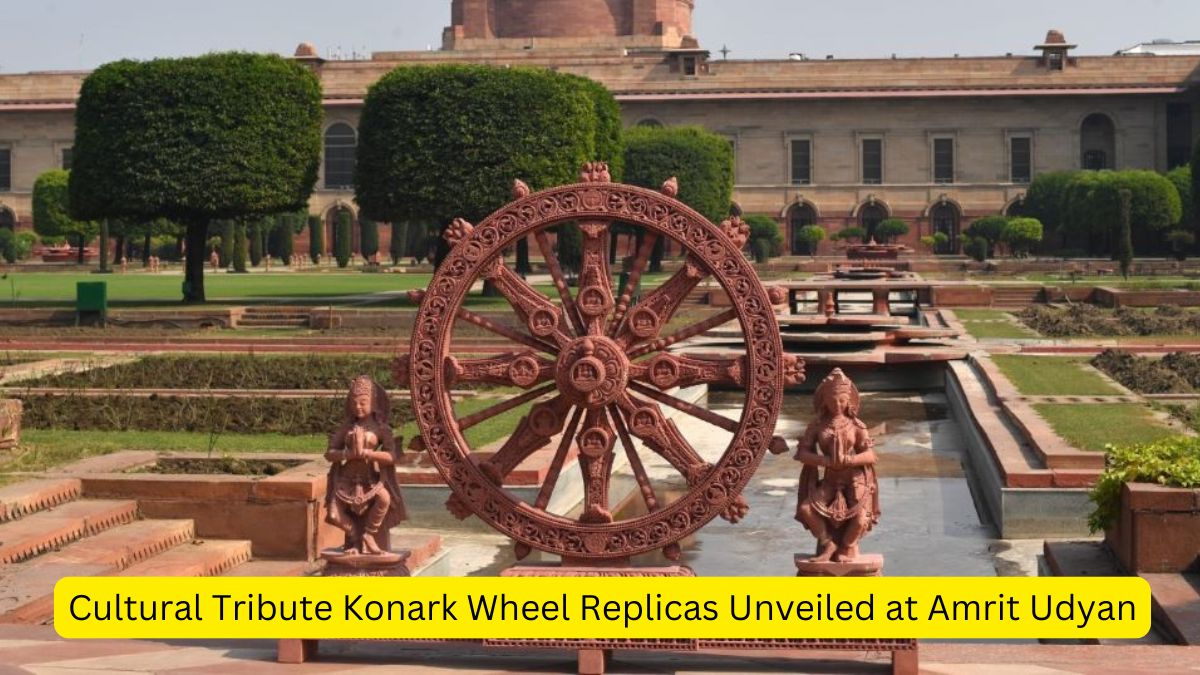Four sandstone replicas of the iconic Konark wheel have been installed at the Rashtrapati Bhavan Cultural Centre and Amrit Udyan, according to an official statement released. This initiative aims to highlight and promote India’s rich cultural heritage, providing visitors with a deeper appreciation of the country’s historical artistry and craftsmanship.
Objective
- The initiative aims to showcase and promote India’s rich cultural heritage to visitors.
Significance
- The Konark wheel represents a key aspect of India’s artistic and historical legacy.
- This installation is part of a broader effort to integrate traditional cultural and historical elements into the Rashtrapati Bhavan.
Context
- The Konark Sun Temple, where the original wheel is located, is a UNESCO World Heritage Site.
- The temple exemplifies Odisha’s temple architecture and is designed as a colossal chariot carrying the Sun god.
Cultural Importance
- The Konark wheel is not only an architectural marvel but also a symbol of India’s cultural heritage and legacy.
- The installation serves to educate visitors about the historical significance of the Konark Sun Temple and its artistic achievements
Statement by the President’s Office
- The introduction of these replicas is part of efforts to enhance the cultural experience at Rashtrapati Bhavan, providing deeper insights into India’s traditional artistry
About Konark Sun Temple
General Information
- Deity: Dedicated to the Hindu Sun God Surya.
- Location: Situated in Konark, approximately 35 kilometers northeast of Puri city on the coastline of Puri district, Odisha.
Historical Context
- Constructed during the reign of King Narasimhadeva I of the Eastern Ganga dynasty around 1250 CE.
- The temple is renowned for its intricate architecture and sculptures.
Cultural Significance
- UNESCO World Heritage Site: Declared in 1984.
- Pilgrimage Site: A major pilgrimage destination for Hindus, particularly during the Chandrabhaga Mela held annually in February.
- Other Names: Referred to as the “Black Pagoda” in European sailor accounts due to its dark appearance, while the Jagannath Temple in Puri is known as the “White Pagoda.”
Architectural Features
- Design: The temple is designed in the form of a gigantic chariot drawn by seven spirited horses.
Wheels
- 24 wheels at its base, each adorned with intricate decorations.
- Each wheel has a diameter of 9 feet 9 inches, with 8 wider spokes and 8 thinner spokes.
Arrangement
- 6 wheels on either side of the main temple, 4 on each side of the Mukhasala, and 2 on each side of the steps at the eastern front.
Significance of the Konark Wheel
Symbolism
- The seven horses represent the days of the week.
- The 12 pairs of wheels symbolize the 12 months of the year.
- The 24 wheels signify the 24 hours of a day.
- The 8 major spokes can represent prahars (three-hour periods) of a day.
- Some interpretations view the wheels as the ‘Wheel of Life’, representing creation, preservation, and realization.
- Others associate the Wheel of Konark with the Dharmachakra of Buddhism, symbolizing the Wheel of Karma and the Wheel of the Law.
- Sundial Function: The spokes can be used as a sundial to estimate the time of day based on the shadow cast.
Features and Carvings
Architectural Uniformity
- All 24 wheels have similar size and design but differ in carvings.
Wheel Carvings
- Thicker wheels feature circular medallions at their centers, adorned with various decorations.
- Axles project about one foot from the surface, decorated similarly.
Designs
- Rims are intricately carved with foliage patterns and figures of birds and animals.
- Medallions in the spokes depict women in luxurious, often sensual poses.
| Summary/Static | Details |
| Why in the news? | Four sandstone replicas of the iconic Konark wheel have been installed at the Rashtrapati Bhavan Cultural Centre and Amrit Udyan |
| Objective | To showcase and promote India’s rich cultural heritage to visitors. |
| Significance | – The Konark wheel represents a key aspect of India’s artistic and historical legacy.
– Part of efforts to integrate cultural elements at Rashtrapati Bhavan. |
| Context | – The Konark Sun Temple, UNESCO World Heritage Site, is located in Odisha.
– The temple is designed as a colossal chariot for the Sun god. |
| Cultural Importance | – The Konark wheel symbolizes India’s cultural heritage and artistic achievements.
– Educates visitors on the historical significance of the temple. |
| Statement by President’s Office | The replicas aim to enhance the cultural experience at Rashtrapati Bhavan, offering deeper insights into India’s traditional artistry. |
| About Konark Sun Temple | – Deity: Sun God Surya.
– Location: Konark, Odisha. – Constructed: Around 1250 CE during King Narasimhadeva I’s reign. |
| Cultural Significance | – UNESCO World Heritage Site since 1984.
– Major pilgrimage site during Chandrabhaga Mela. |
| Architectural Features | – Designed as a gigantic chariot drawn by seven horses.
– 24 wheels at the base, each with intricate decorations. |
| Konark Wheel Symbolism | – Seven horses represent days of the week.
– 12 pairs of wheels represent months of the year. – 24 wheels symbolize the 24 hours of a day. – Wheels are also viewed as the ‘Wheel of Life’ and related to the Dharmachakra of Buddhism. |
| Features and Carvings | – Carvings include foliage patterns, birds, animals, and medallions featuring women in luxurious poses. |
| Wheel Function | – Spokes can be used as a sundial to estimate time based on the shadow cast. |




 Prime Minister Releases Commemorative Po...
Prime Minister Releases Commemorative Po...
 Parliament Passes SHANTI Bill, AERB Gets...
Parliament Passes SHANTI Bill, AERB Gets...
 Viksit Bharat G RAM G Bill Passed in Lo...
Viksit Bharat G RAM G Bill Passed in Lo...







